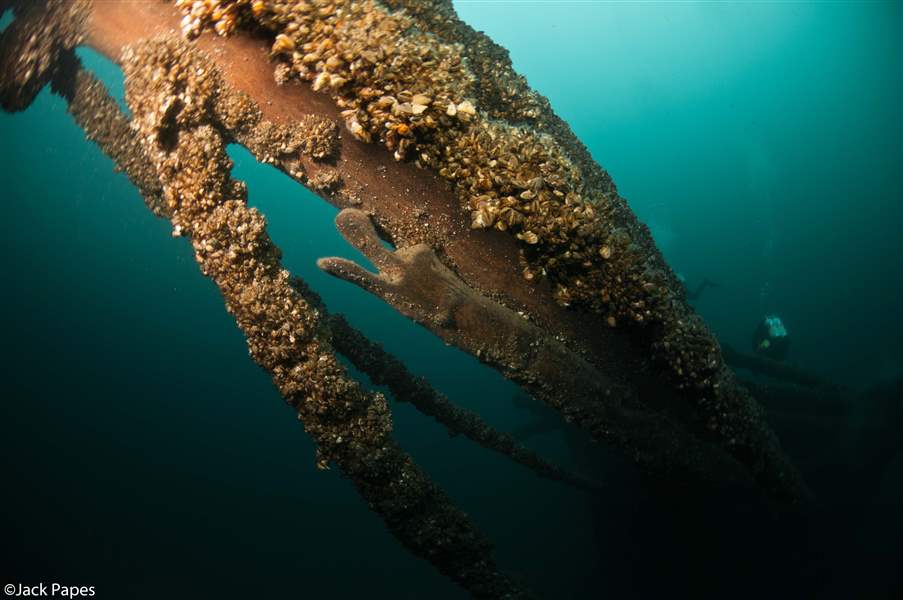
Researcher says new shipwreck 'most important' Lake Erie discovery to date
4/23/2018
Schooner Dunderberg - Launched 1867.
Jack Papes
A shipwreck hunter affiliated with the National Museum of the Great Lakes has located what is believed to be the oldest shipwreck ever discovered in Lake Erie: a schooner that sank east of Kelleys Island in 1829.
Tom Kowalczk, director of remote sensing for the Cleveland Underwater Explorers, first observed wreckage now thought to be that of the schooner Lake Serpent while using side-scan sonar to survey Lake Erie’s bottom nearly three years ago.
Since then, according to a prepared statement released by the museum, Mr. Kowalczk and other CLUE and museum researchers studied records to identify the mysterious shipwreck.
Exploring the shipwreck could reveal lost details about ship designs from the early 19th century, Christopher Gillcrist, the museum’s executive director, said, noting that shipbuilders of that period in Cleveland used methods different from those in say, Detroit or Buffalo.
“We never know what we’re going to find once we’re down there,” the museum director said. “There’s always the chance it will teach us something about the history of Lake Erie shipbuilding in the early 19th century.”
The wreck in question was found in an area where the Lake Serpent was lost in 1829, and is very similar in size and design to that long-lost vessel, Carrie Sowden, an archaeologist and director of the museum’s Peachman Great Lakes Shipwreck Research Center, said in a statement.
The museum now is mounting a public fund-raising campaign to pay for partial excavation and documentation of the shipwreck to confirm its identity.
“Based on the vessel’s enrollment papers, the Lake Serpent has a carved sea-serpent figurehead below the bowsprit of the vessel. We intend to excavate around that portion of the wreck to determine the identity of this important discovery and have filed for permits to do so,” Ms. Sowden said.
Mr. Gillcrist said museum members and four other organizations have already provided about $6,000 of the estimated $13,000 cost to survey the wreck.
“We hope that the general public will see the value of supporting this investigation with contributions of $10 and above to help us determine if we have found the oldest commercial shipwreck ever discovered on Lake Erie,” Mr. Gillcrist said. “This is a chance for everyone to be a ground-floor benefactor of the most important discovery to date on Lake Erie.”
Commemorative T-shirts and bumper stickers will be among premiums offered to campaign donors.
According to a “discovery report” prepared by Mr. Kowalczk, the partially submerged wreckage was observed as a “small, barely noticeable anomaly” in the lake bottom while he hunted for shipwrecks on July 23, 2015.
“The target was so small it was almost dismissed as a natural artifact,” he wrote. “We were looking for shipwrecks! Curiosity got the upper hand and the boat was turned for a second look.”
A review of reported lost vessels narrowed the field of possibilities first to 11 by the discovery’s approximate size, then to three by its location.
But details of the other two missing vessels, Mr. Kowalczk wrote, “strongly suggest” this one is the Lake Serpent, which sank while hauling limestone from the Lake Erie Islands to Cleveland.
The survey to be performed by divers will attempt to measure the sunken wreck, identify its cargo, verify its mast configuration, and examine its bow to confirm — or deny -— the presence of the serpent figurehead on its bow.
“The existence of a carved head is not unusual. Many vessels had elaborate scrolls carved in the bow (head),” Mr. Kowalczk wrote. “A serpent, however, is unique. This artifact will be positive proof of identity.”
The underwater survey diving is expected to take about 10 days. Anyone interested in donating toward its cost should visit www.indiegogo.com/projects/lakeserpentproject/ for more information, the Great Lakes museum said.
Mr. Kowalczk’s other shipwreck finds include the 2015 discovery of the sunken barge Argo, which was lost in a storm east of Kelleys Island in 1937 with a petroleum cargo. Some of that cargo proved to still be on board and was leaking, and the discovery resulted in a federally funded cleanup.
Mr. Kowalczk said he found both the Argo and the Lake Serpent while looking for yet another ship that so far has eluded him: the schooner Lexington, which sank in the same general area of Lake Erie during the mid to late 1840s.
The Lexington’s sinking was well-documented at the time, he said, because initially its masts still protruded above the lake’s surface and both cargo and bodies washed ashore. But the vessel was never salvaged and once lake ice broke its masts off, its location became unknown.
“The history says it’s there. The thing that worries me now is whether it’s now completely buried in the mud, because then I’ll never find it,” Mr. Kowalczk said.
Contact David Patch at dpatch@theblade.com or 419-724-6094.